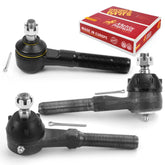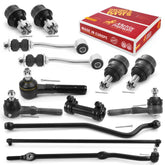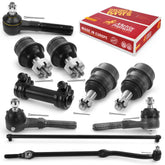What Do I Need to Do After Lifting My Truck?
Whether on the streets or off-roading, you've seen lifted trucks: vehicles sporting larger-than-life tire sizes, riding high, and traversing over rough terrain as if it's nothing. Trucks that have been customized with a lift kit offer drivers an incredibly unique experience. If you have decided to install a lift kit, we're positive you've done your due diligence as far as installation options and high-quality parts. Something you may have overlooked, however, is what you should consider after lifting your truck.
A lift kit grants you additional capabilities with your vehicle, and given these sorts of changes, you must consider how your vehicle will operate differently, how it should be maintained, as well as other factors. If you have recently decided to lift your truck, here's what to keep in mind about the next steps:
Adjust Gear Ratios
The manufacturer tuned your vehicle's gear ratios based on tire height. Its engine will not be able to spin the tires properly at these old gear ratios, so adjustment is necessary. If you are unsure as to how to adjust them yourself, know that a reputable mechanic can handle the job quickly.
Upgrade Suspension
If you are still using the truck's stock suspension, it may not be able to handle your new tires because of the weight. Those in lifted trucks often upgrade their suspension, switching to lighter wheels to offload the strain. By not upgrading your suspension, you may have difficulty controlling your truck while driving. Periodically checking — and if necessary, replacing — your steering system is recommended.
Additionally, whenever you upgrade the suspension, you must check the drivetrain to ensure it's on the same level as your new suspension is. That includes axles, gears, lockers, and differential covers.
Get New Brakes
Brakes on lifted trucks must be stronger than those on their standard counterparts. Even if your factory-installed brakes are able to stop the larger tires from moving, they will wear out quicker. Regardless, after you lift your truck, it's time to upgrade from the stock brakes.
Install Long Shock Absorbers
You may have heard that lifted trucks can be more uncomfortable to ride in than regular trucks. However, that doesn't have to be the case! Instead of a less than pleasurable ride, switch out your shock absorbers for a longer variety. You'll notice the difference on and off the road!
You have probably heard that lifted trucks can be more uncomfortable to ride in than regular trucks are, but that does not have to be the case. Instead of riding in discomfort, switch out your shocks. Go with long shock absorbers. You will notice the difference whether you are on or off the road.
Keep Up With Maintenance
Cleanliness is excellence! Larger rolling stock puts more stress on wheel bearings and seals. Keeping the lifted truck clean makes it easier to notice problem areas in the drivetrain. Bearing and seal failure can be substantially reduced by checking hub and axle fitment each time your tires are rotated. Additionally, ensure the axle nut has the proper tension; this reduces flex in the hub assembly, resulting in longer-living parts.
For more information about getting the most out of your lifted ride with premium products — including 1999 Dodge Ram 1500 Front Suspension Kits and '99 Tahoe Front Suspension Kits to 2003 Jeep Liberty Tie Rod Ends and beyond — from a leading provider, reach out to Metrix Premium Chassis Parts today!









